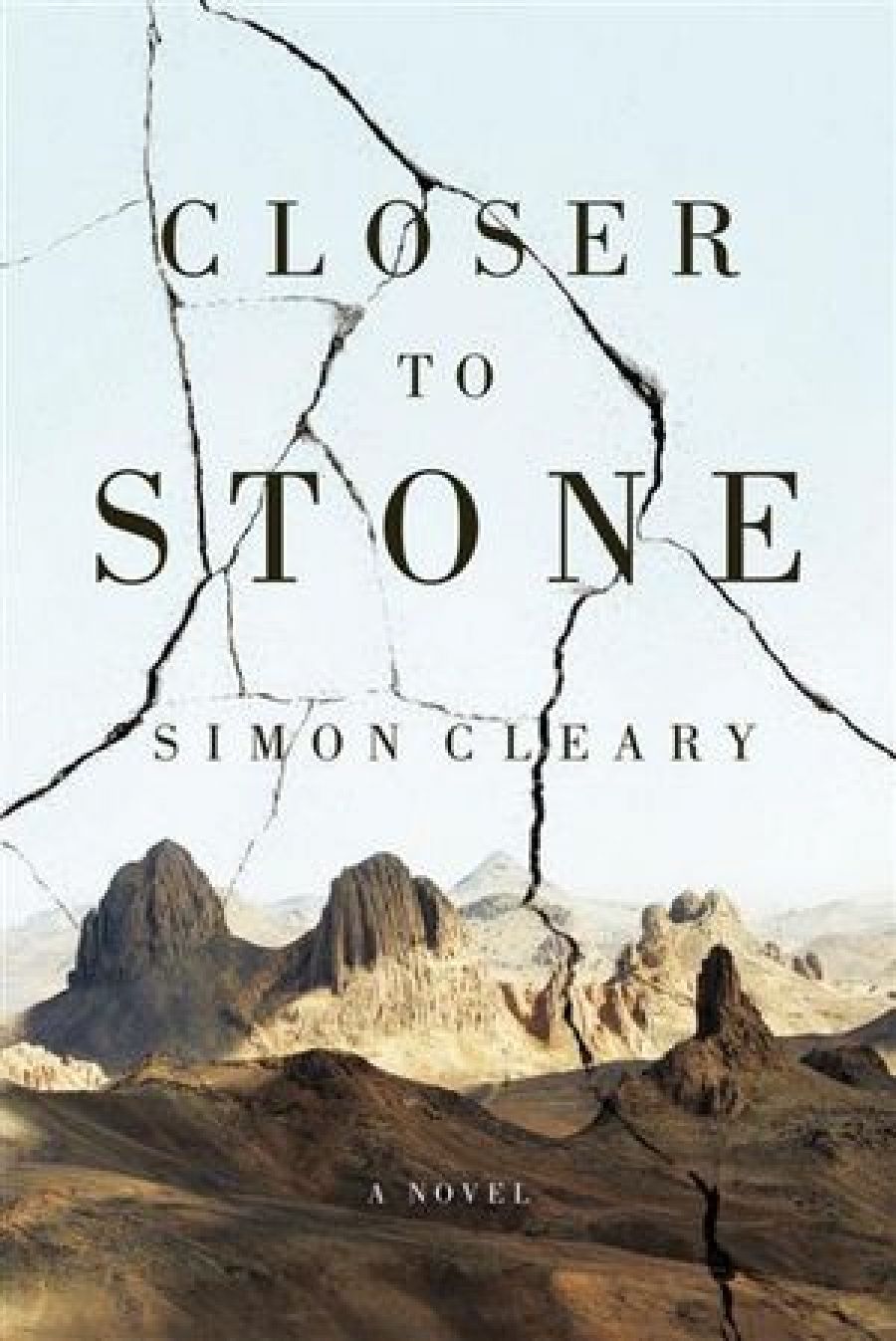
- Free Article: No
- Contents Category: Fiction
- Custom Article Title: Dean Biron reviews 'Closer to Stone' by Simon Cleary
- Review Article: Yes
- Online Only: No
- Custom Highlight Text:
About a third of the way into Simon Cleary’s Closer to Stone, all of the preceding distinctively phrased metaphors and similes, all of the fragrant, lucid imagery – along with some that is rather less than lucid: how, exactly, does one pick up a drink and take a ‘deep sip’? – begin to meld into a compelling whole. Narrator Bas Adams, scouring the immense unknown of the Sahara Desert in southern Algeria for his brother Jack, who has been absent without notice from duty as a United Nations peacekeeping soldier, has come across the woman who last saw him alive. Sophia, a strong-willed, self-sufficient American schoolteacher, informs Bas that Jack had been undergoing a process of recuperation, though not from any physical ailment: ‘his need,’ she says, ‘was like a wound [...] he was dying inside, and he had the courage to choose another life.’
- Book 1 Title: Closer to Stone
- Book 1 Biblio: University of Queensland Press, $29.95 pb, 304 pp
- Book 1 Readings Link: https://www.booktopia.com.au/closer-to-stone-simon-cleary/book/9780702239229.html
Unfortunately, the sense of order does not last. Another hundred or so pages on, roughly when Part Two of the book (the strongest) gives way to Part Three (the weakest), Closer to Stone descends into a confusion of fantastic plot twists and strained personality turns from which it never recovers. The didactic but unconvincing aspect of this politically charged tale leaves the reader floundering by the wayside. The narrative creates a satisfying buzz of expectation during Bas’s search for Jack, including one particularly spooky moment when he momentarily perceives a figure standing on a distant ridge. It falls into general disrepair, however, once the hunt is over and the focus of the novel alters. Add Sophia, who has been intimate with both of them, as a confounding variable, and what emerges is a story that attempts to be both philosophically and politically astute, but in the end is neither.
Bas’s excursion into the remote interior of the African continent has drawn predictable (and lazy) comparisons with Joseph Conrad’s Heart of Darkness. A more fruitful contrast might be made with a musical example of such a journey. In 2004 the Seattle-based Sublime Frequencies label released Bush Taxi Mali, an album of field recordings made across the North African country that is located just below Algeria. One of a number of portraits of African and Asian nations released by the label, this beguiling concoction of overheard radio broadcasts, street sounds and snatches of conversation and music creates an essentially neutral image of a little-known society: the sonic terrain is laid out for the listener to experience and make of it what they will. By contrast, Closer to Stone, like so many literary journeys made by First World writers into developing world settings, seems so caught up with accounting for the ‘otherness’ of the environment that it comes across more as an outsider’s authoritative critique than as an exploration. The indigenous people of the Saharan region are presented as otherworldly, chiefly understood by those characteristics that conflict with the Occidental. Those who do not come across as benign and uncomprehending are instead alien and potentially malevolent, such as the male Muslim fundamentalists whom Bas repeatedly refers to as ‘the beards’.
A map of the African continent leads Bas to envisage ‘a disembodied head stripped of its flesh [...] clearly, unmistakeably, the skull of some primitive hominid, some time-blasted ancestor of ours, gazing off to the east, blank and emotionless’. This would be a less discomfiting episode in a novel that reaches some kind of critical dénouement concerning its lead character’s cultural disconnection, but I am not satisfied that Closer to Stone does this. In a story that moves from Queensland to Africa to the United States, the complex intertwining of colliding politics and religions, ultimately manifested in the real-life events of 9/11 and the 2002 Bali bombings, is crucial to the plot, yet somehow removed from it. The African landscape is presented in fine detail, quite brilliantly at times; the author succeeded in making me feel as though I was out there in the desolate towns, the undulating sand dunes, the stark gibber plains. But at no point did I feel entirely comfortable about why I was there.
Nor is the complementary narrative stream, which focuses on Bas as a lapsed sculptor, very persuasive. In fact, one could go so far as to say that Bas as a character and narrator is for the most part unconvincing. He is a strangely unsympathetic figure, which is not a problem in itself – why should the reader approve of the central character? Yet one might contrast a wretched protagonist such as Charles Arrowby from Iris Murdoch’s classic The Sea, The Sea (1978), who is imbued with a complexity and portrayed with a delicacy that overrides all other objections. Arrowby’s estrangement from his previous life in the theatre makes perfect sense; Bas’s calling as a sculptor seems tacked on, almost an afterthought.
In what appears to be a fairly common trait among the work of new writers these days, Closer to Stone provides clear evidence of the considerable ability of Simon Cleary as a novelist without going so far as to qualify as a significant novel. Simon Cleary’s next book will be crucial in establishing if he is destined to fulfil his obvious potential.


Comments powered by CComment